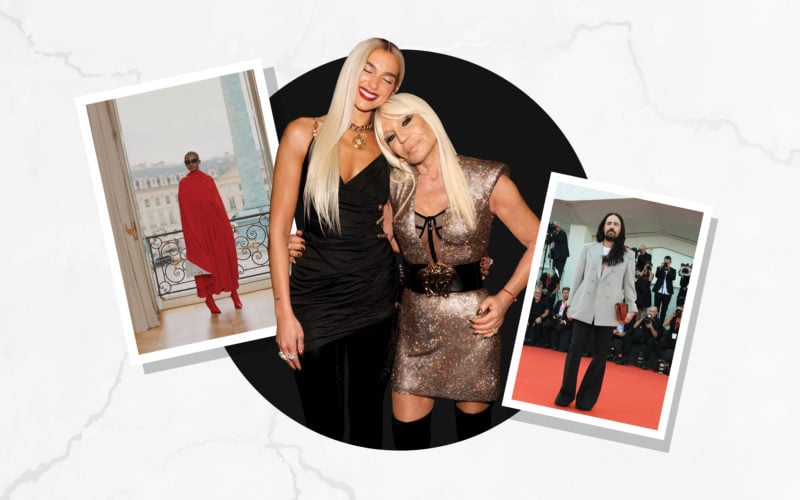Shocking resignations. Reverse cancel culture. Celebrities becoming designers. Change in the fashion industry seems rampant right now. Why?
Fashion loves nothing more than change. It’s the reason trends are created, discarded and resurfaced years later with enough separation to feel totally new, or why rotating brands take the top spot every few seasons as bastions of all that is fresh and exciting. In an industry that functions on ideas, there’s an endless demand for innovation to keep things feeling, well, in vogue. But over the past few months, fashion’s accelerated penchant for shaking things up has given us whiplash. So here, we’re breaking it down.
RELATED: Fashion Is Going Through a Minimalist Vibe Shift
The creative director mass exodus
As the most important person in a fashion house, creative directors are the heartbeat of brands. Their decisions dictate a label’s cultural standing: from runway gimmicks to celebrity partnerships to viral controversies (more on that later). This is why it feels particularly jarring that so many of them are stepping down.
In November 2022, news that Alessandro Michele was leaving Gucci after nearly eight years sent shockwaves through the industry. But it’s since become just one piece of a larger trend. Raf Simons shuttered his namesake brand. Jeremy Scott exited Moschino. Tom Ford quit his eponymous label. Most recently, on June 5, news spread that Gabriella Hearst would reportedly be leaving Chloé after an impactful three-year tenure. Each month, the list has grown longer — accented by the untimely retirement announcement of top stylist Law Roach — sparking speculations as to whether there are industry-wide changes brewing behind the scenes.
And in some ways, there are. For starters, these shifts coincide with an aesthetic change of tides. In the age of resurfaced minimalism, recession core and quiet luxury, cultural tastes are different than they were even three years ago. Jasmine Kharazi (@jasminedarya), a content creator and fashion commentator, points to the head-spinning speed of TikTok trend cycles as one possible cause for the creative director shuffle. Amid changing attitudes, it’s a way to attract eyeballs. Case in point: When Gucci pivoted from Michele’s wildly popular maximalism to a Fall 2023 collection that felt intentionally pared down, it was not met with all rave reviews. But it certainly drew “what now?” anticipation.
Rebecca Halliday, an assistant teaching professor at the University of Victoria whose expertise includes the intersection of fashion and media, says the “musical chairs nature” of creative directors is actually nothing new. And for established figures like Ford and Michele, it makes sense. “There might just be a sense for those creative directors that their work with that particular fashion house is done, and they are ready to move on to the next project,” she says. Plus, maybe they’re just tired! Can you blame them? These days, “helming a brand is more gruelling than ever,” writes Leah Faye Cooper in Vanity Fair, citing expectations of seasonal reinvention, high-profile celebrity red carpets and the omnipresent pressure to go viral. Already, we’ve seen how the latter can take precedence over just about anything. This brings us to our next point.
Questionable comebacks
In 2021, this publication’s fashion news director Annika Lautens lamented the industry’s “problematic short-term memory” with respect to the re-embrace of Dolce & Gabbana, despite the brand’s racist and homophobic history. And in 2023, fashion’s tendency for such redemption arcs is increasingly obvious. Take Alexander Wang. Despite several allegations of sexual assault, the designer re-entered the New York Fashion Week circuit in February, with Julia Fox on the catwalk and Anna Wintour in the audience. The industry at large made not a peep.
Even more recent is Balenciaga’s return. In November 2022, the brand was shunned when it released a highly regrettable ad campaign accused of child sexualization. After a turbulent company response, a wave of TikTok furor, and a self-imposed break from the spotlight, mere months later, Balenciaga is back. Creative director Demna was at the Met Gala. Stars like Michelle Yeoh and Salma Hayek wore Balenciaga at the Cannes Film Festival. And with a newly released resort collection asserting that “the brand transcends its current predicament,” the industry has made space for Balenciaga’s redemption. To Halliday, this is not all that surprising.
“While social media facilitates the viral spread of outrage and conspiracy theories…the speed at which lines can come out with new campaigns or drops allows people to move on to the next collection, or the next outrage, even though the scandal lives on as an internet footprint,” she says. To Kharazi, these particular comebacks are an indication of shortened attention spans, specifically on TikTok. “To me, [this shows] that cancel culture, as good-intentioned as it might be, isn’t a good long-term strategy and clearly doesn’t work,” she says. And on the topic of recognition trumping worthiness…
Celebrities turned designers
Should famous people create clothing lines? It’s a contentious question — namely because it can result in lost opportunities for up-and-coming talent — but it’s something fashion loves to surface. Dua Lipa just teamed up with Versace to develop a line that premiered at Cannes. After announcing her new apparel brand, Angelina Jolie co-designed a capsule collection with Chloé. In September 2022, Kim Kardashian curated her own line — based on herself, obvi — for Dolce & Gabbana.
The appeal for brands is obvious: Having a celeb as a designer makes them synonymous with the label, as opposed to just another advertiser. “[There appears] to be an intention to work with someone who isn’t just of the moment but who really embodies the ethos and the aesthetic of that particular line,” says Halliday. (Dua Lipa has long been Donatella Versace’s muse; the controversial reputations of Kim Kardashian and Dolce & Gabbana are kinda complementary.) Though the merge of celebrity and fashion lines is not new, its increased ubiquity has raised eyebrows. “At best, the recent move toward hiring celebrity ‘designers’ highlights luxury’s growing desire to turn a quick buck off of a famous collaborator’s name rather than risk trying something (or someone) new,” argues Jake Silbert for Highsnobiety.
The bottom line
Today, fashion and pop culture are increasingly intertwined, says Kharazi. “People like me are able to gain a following from solely talking about these topics,” she reflects. “Fashion is changing rapidly, the news is changing rapidly, and pop culture is consumed faster than ever.” The aforementioned shake-ups may not be entirely novel, but they do mirror fashion’s current climate. In an era of economic uncertainty, social issues emphasized on a global scale and algorithm-based discourse at an all-time high, fashion has to find new ways to be political, says Halliday, just like it always has. Much of the industry’s startling “newness” isn’t so new after all — it’s just old cycles sped up. The question is, how much faster can it all really go?









Add Comment